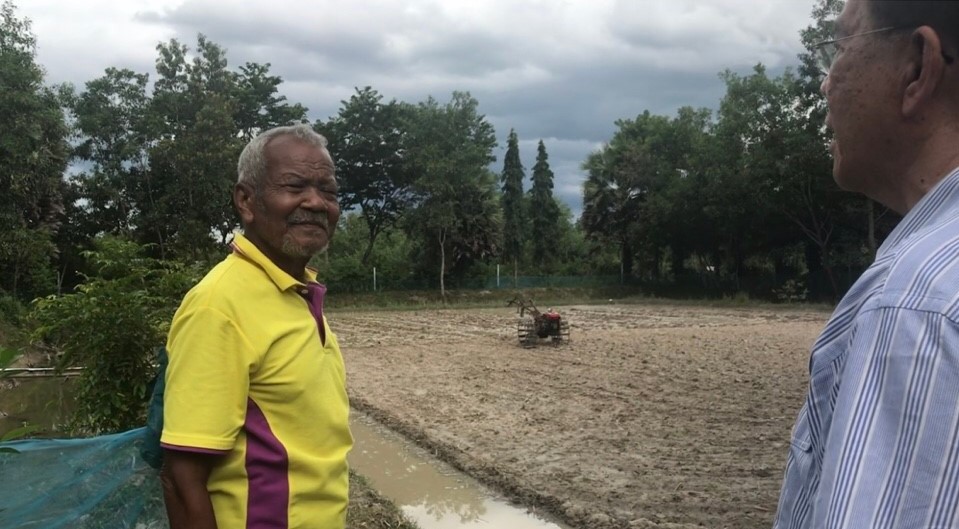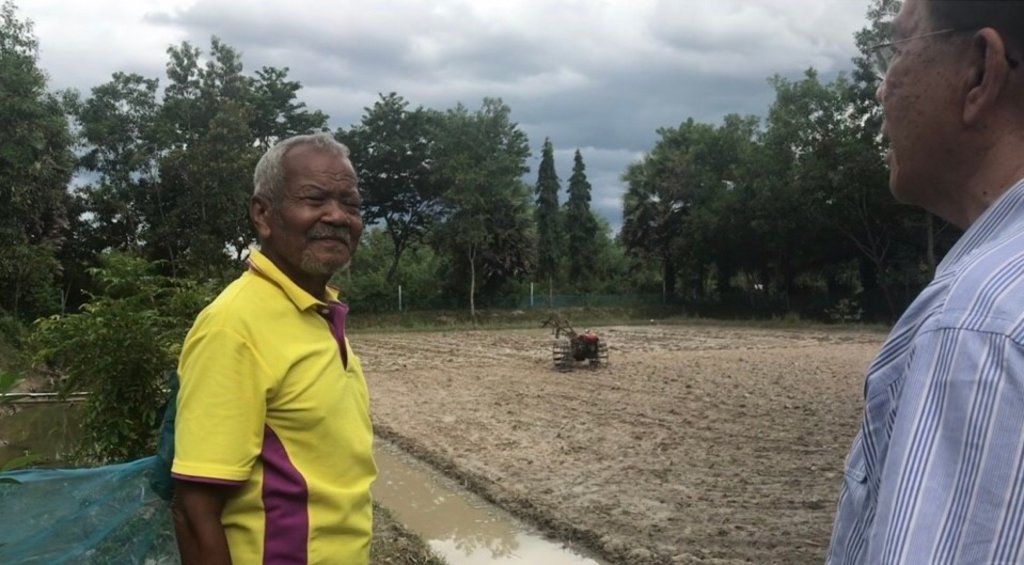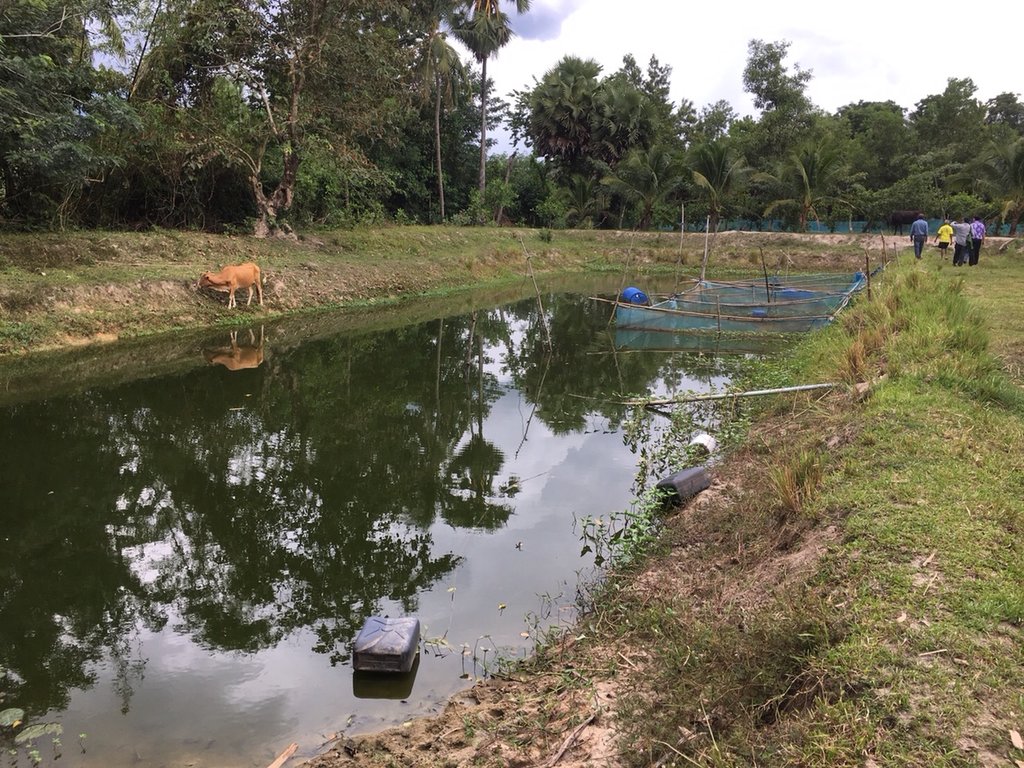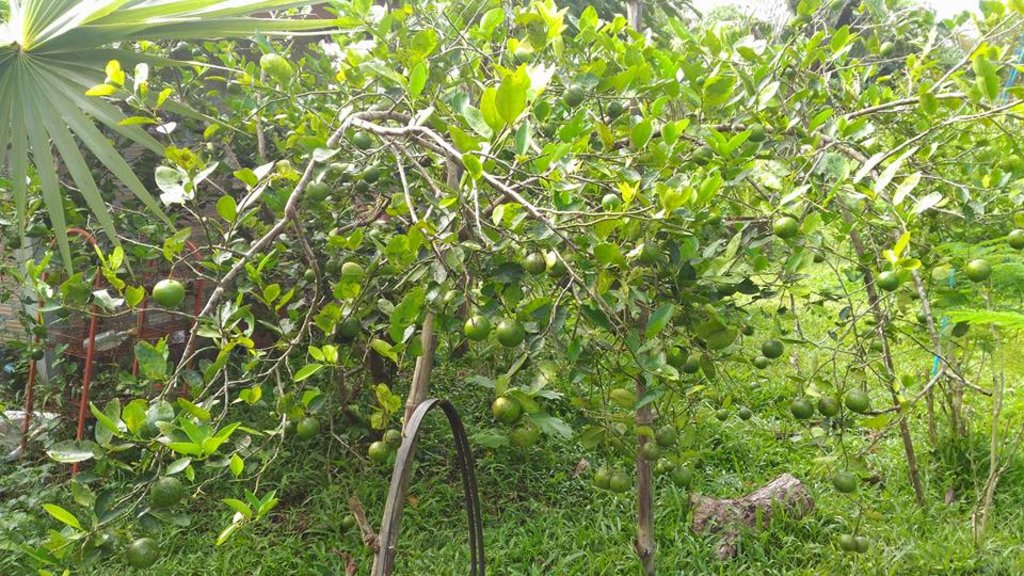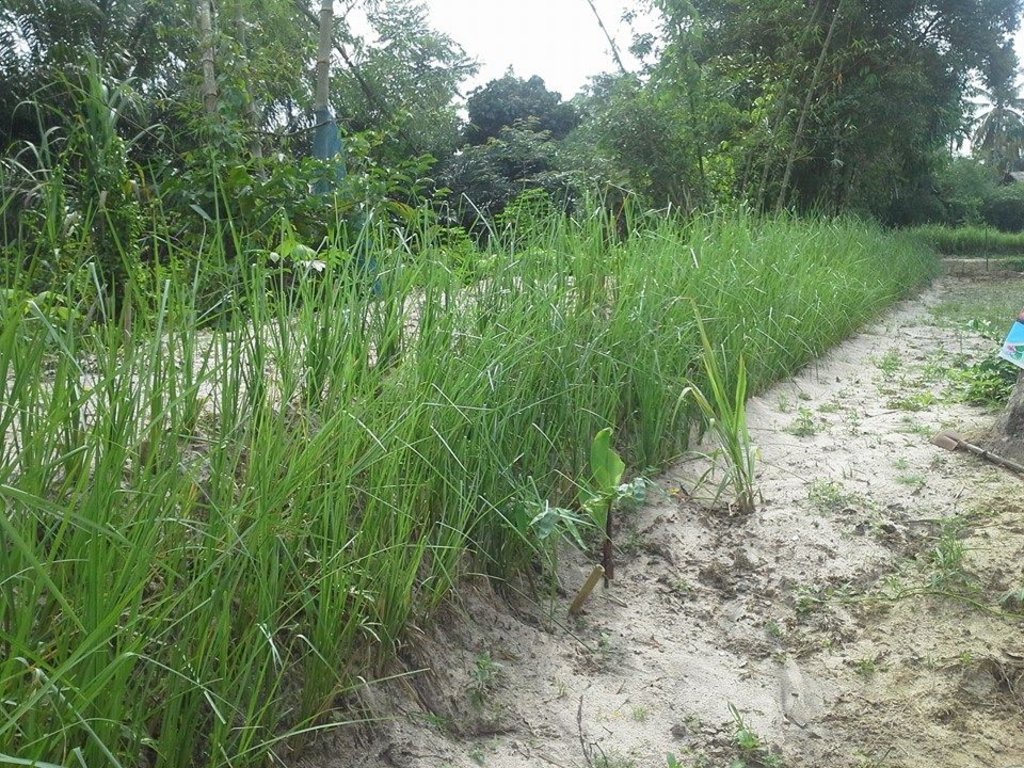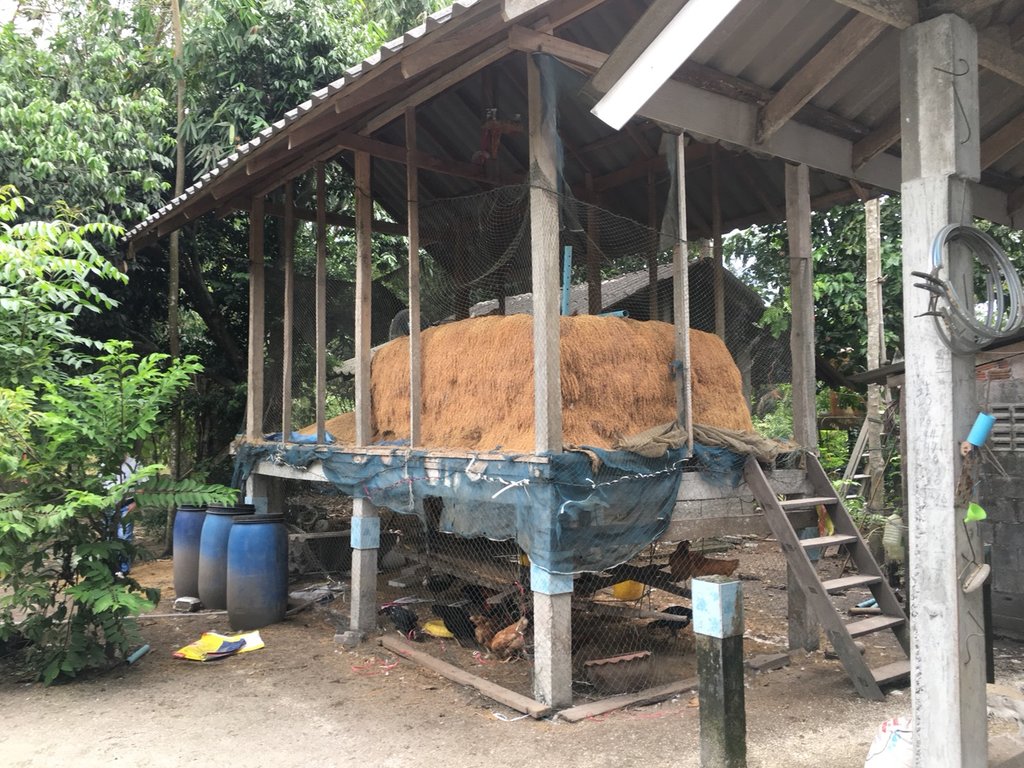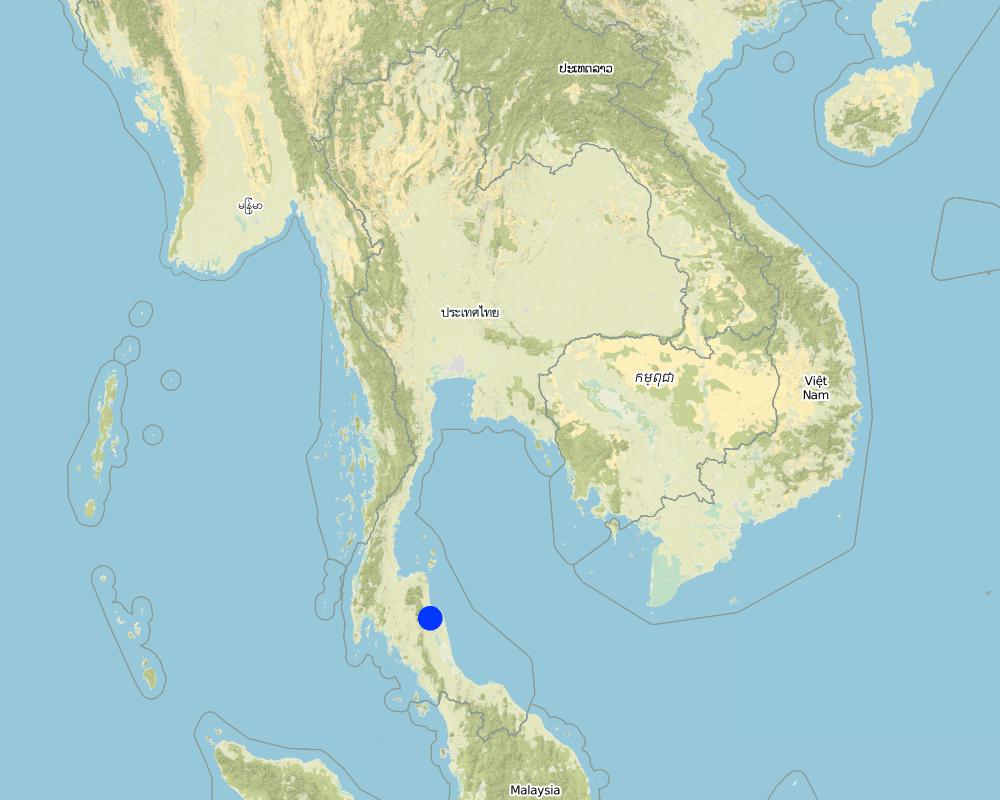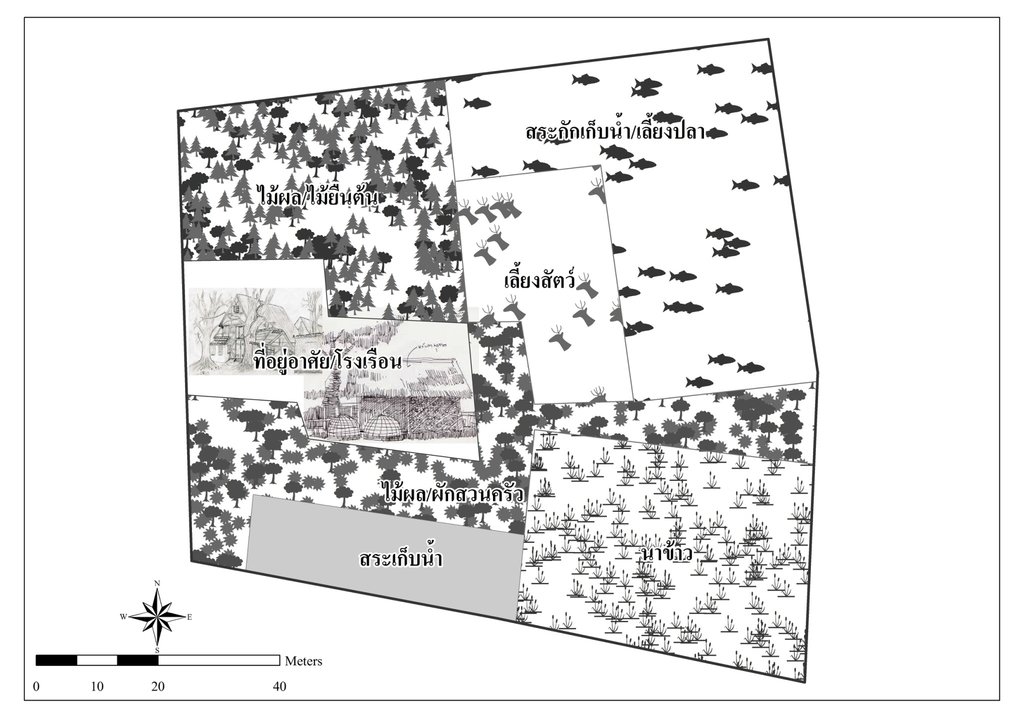The new theory of agriculture for mixed farming system [Thailand]
- Creation:
- Update:
- Compiler: Prapa Taranet
- Editor: –
- Reviewer: Rima Mekdaschi Studer
The royal new theory of agriculture
technologies_4146 - Thailand
View sections
Expand all Collapse all1. General information
1.2 Contact details of resource persons and institutions involved in the assessment and documentation of the Technology
Key resource person(s)
land user:
Singhophon Chaung
Thailand
Name of project which facilitated the documentation/ evaluation of the Technology (if relevant)
Decision Support for Mainstreaming and Scaling out Sustainable Land Management (GEF-FAO / DS-SLM)Name of the institution(s) which facilitated the documentation/ evaluation of the Technology (if relevant)
Land Development Department (Land Development Department) - Thailand1.3 Conditions regarding the use of data documented through WOCAT
The compiler and key resource person(s) accept the conditions regarding the use of data documented through WOCAT:
Yes
1.4 Declaration on sustainability of the described Technology
Is the Technology described here problematic with regard to land degradation, so that it cannot be declared a sustainable land management technology?
No
2. Description of the SLM Technology
2.1 Short description of the Technology
Definition of the Technology:
Allocating and managing small-scale farm areas to make it be able to use for agricultural production with the highest efficiency
2.2 Detailed description of the Technology
Description:
The new theory of agriculture is the application of mixed farming systems to poor farmers on small land holdings in Chang Sai sub-district, Phra Phrom district, Nakhon Si Thammarat province, Thailand. The most important concept of new theory farming is an efficient allocation of land to serve the different needs of farm households, including paddy fields, farm ponds for water and fishes, and cash crops, fruit trees, and trees for farm income, plus a residential area. It has a goal to solve the problem of shortage of land and water resources, which is a very important problem in Thailand, for making a living of smallholder farmers. Apart from the fact that the size of the area and water resources are the limit factors for farmers in this area, the land is also degraded causing by both natural and human activities. The area is classified as sand dunes with low to very low soil fertility where farmers mostly grew same plant species in the whole area during the rainy season of every year. This results in high risks in regard to a fluctuation of the amount of production and insufficient food crop production for household consumption. Therefore, land allocation for agriculture under the concept of the new theory agriculture can be the appropriate measure in making use of resources of small-scale areas for optimal benefits and increase incomes for a household. Nowadays, farmers in the adjacent area realized the benefits obtained from allocating the area, they formed a group of farmers in order to set up management, improve the use of their small-scale areas for optimal benefits.
The new agricultural theory was initiated by His Majesty the Late King Bhumibol Adulyadej of Thailand to provide help for farmers who had small-scale areas for agricultural purposes. For the land allocation, the land is divided into 4 parts. Part 1 is designated for a pond to store rainwater during the rainy season and to supply water to grow crops in the dry season as well as for raising aquatic animals (fishes, field crabs) and plants (such as morning glory, water mimosa, etc.). Part 2 is set aside for rice cultivation during the rainy season as a daily staple in households throughout the year sufficiently, which cut down on expenses and allow the farmers to be self-reliant. Part 3 is used for growing fruit and bearing trees, perennials, vegetables, field crops for daily consumption. If any surplus from consumption, it can be sold. Part 4 is used for dwelling, animal husbandry, roads and other structures (barn, straw, pile of compost, houses, mushroom nurseries, stalls, flowering-plants, ornamental plants, home-grown vegetables of backyard gardens). In any case, the proportion of the area in each section can be adjusted for either increase or decrease depending on the suitability of area conditions of each location and the necessity of farmers who make use of the area, but it is usually 30:30:30:10.
2.3 Photos of the Technology
2.5 Country/ region/ locations where the Technology has been applied and which are covered by this assessment
Country:
Thailand
Region/ State/ Province:
Nakhon Si Thammarat province
Further specification of location:
Chang Sai sub-district, Phra Phrom district
Specify the spread of the Technology:
- applied at specific points/ concentrated on a small area
Is/are the technology site(s) located in a permanently protected area?
No
Map
×2.6 Date of implementation
Indicate year of implementation:
2010
2.7 Introduction of the Technology
Specify how the Technology was introduced:
- through projects/ external interventions
Comments (type of project, etc.):
This technology was initiated by His Majesty the Late King Bhumibol Adulyadej of Thailand and disseminated to farmers by several departments under Ministry of Agriculture and Cooperatives
3. Classification of the SLM Technology
3.1 Main purpose(s) of the Technology
- improve production
- reduce, prevent, restore land degradation
- create beneficial economic impact
3.2 Current land use type(s) where the Technology is applied
Land use mixed within the same land unit:
No

Cropland

Other
Specify:
Mixed farming system
Remarks:
cropland mixed with aquatic animals
Comments:
Crops include rice, vegetable, limes, tropical fruits, and trees, while aquatic animals include a variety of fishes, field crabs.
3.3 Has land use changed due to the implementation of the Technology?
Has land use changed due to the implementation of the Technology?
- Yes (Please fill out the questions below with regard to the land use before implementation of the Technology)
Land use mixed within the same land unit:
No

Cropland
- Annual cropping
Annual cropping - Specify crops:
- cereals - rice (wetland)
Is intercropping practiced?
No
Is crop rotation practiced?
No
3.4 Water supply
Water supply for the land on which the Technology is applied:
- rainfed
3.5 SLM group to which the Technology belongs
- water harvesting
- home gardens
3.6 SLM measures comprising the Technology

agronomic measures
- A1: Vegetation/ soil cover
- A2: Organic matter/ soil fertility

vegetative measures
- V2: Grasses and perennial herbaceous plants

structural measures
- S5: Dams, pans, ponds

management measures
- M2: Change of management/ intensity level

other measures
Specify:
Introduction of aquatic animal
3.7 Main types of land degradation addressed by the Technology

chemical soil deterioration
- Cn: fertility decline and reduced organic matter content (not caused by erosion)

water degradation
- Ha: aridification
3.8 Prevention, reduction, or restoration of land degradation
Specify the goal of the Technology with regard to land degradation:
- reduce land degradation
4. Technical specifications, implementation activities, inputs, and costs
4.1 Technical drawing of the Technology
Technical specifications (related to technical drawing):
Land allocation according to new theory of agriculture in the area with the size of 5.3 rai of informants by dividing the land into 4 parts, first part is the ponds accounting for 1.5 rai (about 28% of the total area), second part is paddy field accounting for 1 rai (about 19% of the total area), third part is for growing fruit-bearing trees, home-grown vegetables, perennials accounting for 1.3 rai (about 25% of the total area) and last is for building construction for dwelling, animal husbandry and other constructions accounting for 1.5 rai ( about 28% of the total area).
Author:
Prapa Taranet
Date:
20/09/2018
4.2 General information regarding the calculation of inputs and costs
Specify how costs and inputs were calculated:
- per Technology area
Indicate size and area unit:
5.3
If using a local area unit, indicate conversion factor to one hectare (e.g. 1 ha = 2.47 acres): 1 ha =:
6.5
other/ national currency (specify):
Baht
If relevant, indicate exchange rate from USD to local currency (e.g. 1 USD = 79.9 Brazilian Real): 1 USD =:
33.0
Indicate average wage cost of hired labour per day:
300 Baht
4.3 Establishment activities
| Activity | Timing (season) | |
|---|---|---|
| 1. | Pond construction | dry season |
| 2. | Labours | rainy season |
| 3. | Seeds | rainy season |
| 4. | Seedling | rainy season |
| 5. | Aqautic animals (fishes and field crabs) | rainy season |
4.4 Costs and inputs needed for establishment
| Specify input | Unit | Quantity | Costs per Unit | Total costs per input | % of costs borne by land users | |
|---|---|---|---|---|---|---|
| Labour | Cultivation | days | 60.0 | 300.0 | 18000.0 | 100.0 |
| Equipment | Hiring tractors for pond construction | ponds | 3.0 | 16000.0 | 48000.0 | 70.0 |
| Plant material | Seeds | Kilogram | 300.0 | 10.0 | 3000.0 | |
| Plant material | Seedlings | Plants | 100.0 | 50.0 | 5000.0 | 80.0 |
| Fertilizers and biocides | Compost | Ton | 1.0 | 2500.0 | 2500.0 | 50.0 |
| Construction material | Roof tiles | each | 240.0 | 60.0 | 14400.0 | |
| Construction material | Cement | bags | 8.0 | 100.0 | 800.0 | |
| Construction material | Sand and rocks | ton | 1.0 | 1650.0 | 1650.0 | |
| Construction material | Pillars | each | 12.0 | 100.0 | 1200.0 | |
| Other | Fishes and crabs | each | 2500.0 | 1.0 | 2500.0 | |
| Total costs for establishment of the Technology | 97050.0 | |||||
| Total costs for establishment of the Technology in USD | 2940.91 | |||||
If land user bore less than 100% of costs, indicate who covered the remaining costs:
Government agencies
4.5 Maintenance/ recurrent activities
| Activity | Timing/ frequency | |
|---|---|---|
| 1. | Labours | throughout the year |
| 2. | Seeds | rainy season |
| 3. | Seedlings | rainy season |
| 4. | Aquatic animal | 9 months |
4.6 Costs and inputs needed for maintenance/ recurrent activities (per year)
| Specify input | Unit | Quantity | Costs per Unit | Total costs per input | % of costs borne by land users | |
|---|---|---|---|---|---|---|
| Labour | Cultivation | days | 260.0 | 300.0 | 78000.0 | 100.0 |
| Labour | Cultivation | days | 260.0 | 300.0 | 78000.0 | 100.0 |
| Fertilizers and biocides | Compost | ton | 1.0 | 2500.0 | 2500.0 | 50.0 |
| Other | Fishes and crabs | each | 5000.0 | 1.0 | 5000.0 | 30.0 |
| Other | Feeding | month | 9.0 | 5000.0 | 45000.0 | 100.0 |
| Total costs for maintenance of the Technology | 208500.0 | |||||
| Total costs for maintenance of the Technology in USD | 6318.18 | |||||
If land user bore less than 100% of costs, indicate who covered the remaining costs:
Government agencies support some inuts
4.7 Most important factors affecting the costs
Describe the most determinate factors affecting the costs:
Water - if there is a lack of water during the dry season, some agricultural activities may not be practiced. This leads to a reduction of agricultural cost; however, this also leads to a reduction of a household income during that period.
5. Natural and human environment
5.1 Climate
Annual rainfall
- < 250 mm
- 251-500 mm
- 501-750 mm
- 751-1,000 mm
- 1,001-1,500 mm
- 1,501-2,000 mm
- 2,001-3,000 mm
- 3,001-4,000 mm
- > 4,000 mm
Specify average annual rainfall (if known), in mm:
274.00
Indicate the name of the reference meteorological station considered:
Nakhon Si Thammarat meteorological station
Agro-climatic zone
- sub-humid
5.2 Topography
Slopes on average:
- flat (0-2%)
- gentle (3-5%)
- moderate (6-10%)
- rolling (11-15%)
- hilly (16-30%)
- steep (31-60%)
- very steep (>60%)
Landforms:
- plateau/plains
- ridges
- mountain slopes
- hill slopes
- footslopes
- valley floors
Altitudinal zone:
- 0-100 m a.s.l.
- 101-500 m a.s.l.
- 501-1,000 m a.s.l.
- 1,001-1,500 m a.s.l.
- 1,501-2,000 m a.s.l.
- 2,001-2,500 m a.s.l.
- 2,501-3,000 m a.s.l.
- 3,001-4,000 m a.s.l.
- > 4,000 m a.s.l.
Indicate if the Technology is specifically applied in:
- not relevant
5.3 Soils
Soil depth on average:
- very shallow (0-20 cm)
- shallow (21-50 cm)
- moderately deep (51-80 cm)
- deep (81-120 cm)
- very deep (> 120 cm)
Soil texture (topsoil):
- coarse/ light (sandy)
Soil texture (> 20 cm below surface):
- coarse/ light (sandy)
Topsoil organic matter:
- low (<1%)
If available, attach full soil description or specify the available information, e.g. soil type, soil PH/ acidity, Cation Exchange Capacity, nitrogen, salinity etc.
The soil in this area is sandy soil, classified into Coated, isohyperthermic and Typic Quartzipsamments. The parent material is beach ridge or sand dune. The area condition is quite flat up to little undulating with the slope of 1.5%. The soil is very deep and well drained. Water permeability is fast but runoff on the soil surface occurs slowly. The soil reaction is very acidic to a little acidic (pH 5.0 - 6.5) throughout the soil profile. The soil fertility is low. Land use limitation is low fertility and a shortage of water.
5.4 Water availability and quality
Ground water table:
5-50 m
Availability of surface water:
medium
Water quality (untreated):
for agricultural use only (irrigation)
Water quality refers to:
surface water
Is water salinity a problem?
No
Is flooding of the area occurring?
No
5.5 Biodiversity
Species diversity:
- medium
Habitat diversity:
- medium
5.6 Characteristics of land users applying the Technology
Sedentary or nomadic:
- Sedentary
Market orientation of production system:
- mixed (subsistence/ commercial)
Off-farm income:
- less than 10% of all income
Relative level of wealth:
- average
Individuals or groups:
- individual/ household
Level of mechanization:
- manual work
Gender:
- men
Age of land users:
- elderly
5.7 Average area of land used by land users applying the Technology
- < 0.5 ha
- 0.5-1 ha
- 1-2 ha
- 2-5 ha
- 5-15 ha
- 15-50 ha
- 50-100 ha
- 100-500 ha
- 500-1,000 ha
- 1,000-10,000 ha
- > 10,000 ha
Is this considered small-, medium- or large-scale (referring to local context)?
- small-scale
5.8 Land ownership, land use rights, and water use rights
Land ownership:
- individual, titled
Land use rights:
- individual
Water use rights:
- individual
5.9 Access to services and infrastructure
health:
- poor
- moderate
- good
education:
- poor
- moderate
- good
technical assistance:
- poor
- moderate
- good
employment (e.g. off-farm):
- poor
- moderate
- good
markets:
- poor
- moderate
- good
energy:
- poor
- moderate
- good
roads and transport:
- poor
- moderate
- good
drinking water and sanitation:
- poor
- moderate
- good
financial services:
- poor
- moderate
- good
6. Impacts and concluding statements
6.1 On-site impacts the Technology has shown
Socio-economic impacts
Production
crop production
Quantity before SLM:
100
Quantity after SLM:
500
Comments/ specify:
Considering from rice production in 1 rai
crop quality
risk of production failure
Comments/ specify:
As farmer allocates the land to different types of crop, they can evaluate the suitable types of crops for the markets and climatic conditions
Water availability and quality
water availability for livestock
irrigation water availability
Comments/ specify:
Rainwater can be collected in the ponds and this could supply to cultivation during the dry season
Income and costs
expenses on agricultural inputs
farm income
diversity of income sources
workload
Socio-cultural impacts
SLM/ land degradation knowledge
Comments/ specify:
The knowledge about SLM comes through the support of the government agencies
Ecological impacts
Soil
soil moisture
soil cover
soil organic matter/ below ground C
Comments/ specify:
Application of compost in the farm leads to an increase in soil organic matter
Biodiversity: vegetation, animals
beneficial species
Comments/ specify:
Earthworms, Birds, Bees, Cicada, and Varanus.
6.2 Off-site impacts the Technology has shown
groundwater/ river pollution
Comments/ specify:
Agrichemical products did not apply to the farmland, resulting in less soil contamination to environment
6.3 Exposure and sensitivity of the Technology to gradual climate change and climate-related extremes/ disasters (as perceived by land users)
Gradual climate change
Gradual climate change
| Season | increase or decrease | How does the Technology cope with it? | |
|---|---|---|---|
| seasonal temperature | summer | increase | moderately |
6.4 Cost-benefit analysis
How do the benefits compare with the establishment costs (from land users’ perspective)?
Short-term returns:
neutral/ balanced
Long-term returns:
positive
How do the benefits compare with the maintenance/ recurrent costs (from land users' perspective)?
Short-term returns:
positive
Long-term returns:
positive
6.5 Adoption of the Technology
- 11-50%
If available, quantify (no. of households and/ or area covered):
Members in the community (about 50-60 households in the community) and parts of the outside community nearby show interest in this technology because they see that it can increase household incomes and start to implement it in their own areas. However, allocation of the land differs according to the area conditions and the needs of the owners themselves.
Of all those who have adopted the Technology, how many did so spontaneously, i.e. without receiving any material incentives/ payments?
- 0-10%
Comments:
The government provides some inputs for farmers who want to apply this technology to their farmland such as fishes and rice seeds. Then most farmers get some support before they start the activity on the farm.
6.6 Adaptation
Has the Technology been modified recently to adapt to changing conditions?
Yes
If yes, indicate to which changing conditions it was adapted:
- changing markets
Specify adaptation of the Technology (design, material/ species, etc.):
Since organic markets get bigger in the areas, then some farmers produce their products without using agrichemical products. This allows farmers to improve the price for their products.
6.7 Strengths/ advantages/ opportunities of the Technology
| Strengths/ advantages/ opportunities in the land user’s view |
|---|
| Water can be available even in the dry season since this technology includes the farm pond construction for rainwater storage. |
| Farmers should be able to grow enough rice for the whole year’s consumption. |
| Production planning can be done for the household consumption and supply to the market. |
| Strengths/ advantages/ opportunities in the compiler’s or other key resource person’s view |
|---|
| Allocation of the land into 4 parts according to the new theory of agriculture is considered an appropriate option for smallholder farmers who are having small farmland and water shortage. This is due to they can plan what crops, and when, to grow for each growing season based on climatic condition and market. Importantly, farmers learn how to plan the production that will be distributed to the market and for making a living. |
6.8 Weaknesses/ disadvantages/ risks of the Technology and ways of overcoming them
| Weaknesses/ disadvantages/ risks in the land user’s view | How can they be overcome? |
|---|---|
| A lack of household labor results in some farmers adopted only part of technology where the efficiency of this technology may be lower than the adoption of full management. | Mose farmers hire labor or mechanical equipment to help them farming. although this increases the farming cost, it helps farmers to get their work done in time. |
| The cost of investment is rather high, especially for digging the pond. | Farmers ask the support from the government. While some farmers receive 80% help from the government, foundations, and the private sector for digging the ponds, others receive less support from the government. |
| Farmers have limited land for farming, to allocate the land to usual allocation as recommendation may not be suitable. | Farmers changed or improved the allocation ratio by themselves based on the land conditions, climatic condition, and the environment. For example, some farmers who have enough water sources in their areas, the size of the pond can be reduced to make room for other uses. |
| Weaknesses/ disadvantages/ risks in the compiler’s or other key resource person’s view | How can they be overcome? |
|---|---|
| Due to the fact that managing the area with many activities may require more time to take action than monoculture farming, which cannot interest some farmers to practice. Furthermore, it may take time to make it worth the paid expenses due to complexity, little understanding, insufficient labor force, and more hiring may require. | The government needs to take action in the areas to provide more knowledge on this technology and find the solution to the problems. |
7. References and links
7.1 Methods/ sources of information
- field visits, field surveys
1
- interviews with land users
1
- interviews with SLM specialists/ experts
1
When were the data compiled (in the field)?
20/09/2018
7.2 References to available publications
Title, author, year, ISBN:
New Theory of Agriculture, 2011, Office of the Royal Development Projects Board.
Available from where? Costs?
http://www.rdpb.go.th/UploadNew/Documents/%E0%B8%97%E0%B8%A4%E0%B8%A9%E0%B8%8E%E0%B8%B5%E0%B9%83%E0%B8%AB%E0%B8%A1%E0%B9%88.pdf
Title, author, year, ISBN:
Implementation manual for new theory of agriculture, 2015, Ministry of Agriculture and Cooperatives.
Available from where? Costs?
http://www3.oae.go.th/rdpcc/images/filesdownload/SUFFICIENCY/9.9.pdf
7.3 Links to relevant online information
Title/ description:
Sufficiency Economy & New Theory
URL:
http://www.chaipat.or.th/eng/concepts-theories/sufficiency-economy-new-theory.html
7.4 General comments
The long-term impact on household income might change or improve if they practice this technology longer period than 8 years.
Links and modules
Expand all Collapse allLinks
No links
Modules
No modules


